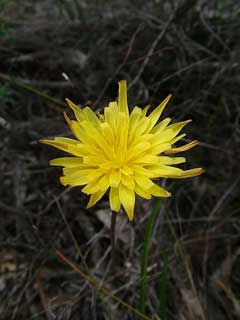 |
|
http://commons.wikimedia.org/wiki/User:Mike_Bayly |
 |
|
Translate this page:
Summary
Physical Characteristics

 Microseris scapigera is a PERENNIAL growing to 0.3 m (1ft). The species is hermaphrodite (has both male and female organs) and is pollinated by Insects.
Microseris scapigera is a PERENNIAL growing to 0.3 m (1ft). The species is hermaphrodite (has both male and female organs) and is pollinated by Insects.
Suitable for: light (sandy), medium (loamy) and heavy (clay) soils. Suitable pH: mildly acid, neutral and basic (mildly alkaline) soils and can grow in saline soils.
It cannot grow in the shade. It prefers moist soil.
UK Hardiness Map
US Hardiness Map
Synonyms
M. forsteri. M. lanceolata. Scorzonera scapigera.
Plant Habitats
Cultivated Beds;
Edible Uses
Edible Parts: Root
Edible Uses:
Root - raw or cooked[2, 46, 61]. Sweetish and moist[144] with a coconut flavour[154]. The root tastes like a sweet potato with an occasional hot taste[173]. It is said to be delicious[193]. The root is between 2 and 8cm long[193]. A favourite food of the Australian Aborigines, who ate the roots in quantity[193]. The root can be harvested all year round but it tastes bitter at certain times of the year, especially in early winter[193].
References More on Edible Uses
Medicinal Uses
Plants For A Future can not take any responsibility for any adverse effects from the use of plants. Always seek advice from a professional before using a plant medicinally.
None known
References More on Medicinal Uses
The Bookshop: Edible Plant Books
Our Latest books on Perennial Plants For Food Forests and Permaculture Gardens in paperback or digital formats.

Edible Tropical Plants
Food Forest Plants for Hotter Conditions: 250+ Plants For Tropical Food Forests & Permaculture Gardens.
More

Edible Temperate Plants
Plants for Your Food Forest: 500 Plants for Temperate Food Forests & Permaculture Gardens.
More

More Books
PFAF have eight books available in paperback and digital formats. Browse the shop for more information.
Shop Now
Other Uses
References More on Other Uses
Cultivation details
We do not have much information on this species and do not know if it will be hardy in Britain, though judging by its native range it should succeed outdoors at least in the milder areas of the country. The Australian form is said to be hardy to at least -7°c in Australian gardens[157], though this cannot be translated directly to British gardens due to our cooler summers and longer colder and wetter winters. Plants are likely to require a well-drained soil in a sunny position. This is a polymorphic species that is found in both New Zealand and in Australia. Some botanists have separated off the Australian form as a distinct species, M. lanceolata[44, 157], which is here used as a synonym. An alpine form in the Snowy mountains of Australia has fibrous roots too thin to be worth eating[193]. The plant has been suggested for commercial cultivation in temperate zones for its edible root[193].
References Carbon Farming Information and Carbon Sequestration Information
Temperature Converter
Type a value in the Celsius field to convert the value to Fahrenheit:
Fahrenheit:
The PFAF Bookshop
Plants For A Future have a number of books available in paperback and digital form. Book titles include Edible Plants, Edible Perennials, Edible Trees,Edible Shrubs, Woodland Gardening, and Temperate Food Forest Plants. Our new book is Food Forest Plants For Hotter Conditions (Tropical and Sub-Tropical).
Shop Now
Plant Propagation
Seed - we have no information for this species but suggest sowing the seed in early spring in a greenhouse. Prick out the seedlings into individual pots when they are large enough to handle and grow them on in the greenhouse for their first winter, planting them out in late spring or early summer. Division in spring might be possible.
Other Names
If available other names are mentioned here
Native Range
AUSTRALASIA: Australia (Tasmania), New Zealand
Weed Potential
Right plant wrong place. We are currently updating this section.
Please note that a plant may be invasive in one area but may not in your area so it's worth checking.
Conservation Status
IUCN Red List of Threatened Plants Status :

Growth: S = slow M = medium F = fast. Soil: L = light (sandy) M = medium H = heavy (clay). pH: A = acid N = neutral B = basic (alkaline). Shade: F = full shade S = semi-shade N = no shade. Moisture: D = dry M = Moist We = wet Wa = water.
Now available:
Food Forest Plants for Mediterranean Conditions
350+ Perennial Plants For Mediterranean and Drier Food Forests and Permaculture Gardens.
[Paperback and eBook]
This is the third in Plants For A Future's series of plant guides for food forests tailored to
specific climate zones. Following volumes on temperate and tropical ecosystems, this book focuses
on species suited to Mediterranean conditions—regions with hot, dry summers and cool, wet winters,
often facing the added challenge of climate change.
Read More
Expert comment
Author
(Sol. ex Cunn.)Sch.Bip.
Botanical References
44154
Links / References
For a list of references used on this page please go here
Readers comment
| Add a comment |
|
If you have important information about this plant that may help other users please add a comment or link below. Only comments or links that are felt to be directly relevant to a plant will be included. If you think a comment/link or information contained on this page is inaccurate or misleading we would welcome your feedback at [email protected]. If you have questions about a plant please use the Forum on this website as we do not have the resources to answer questions ourselves.
* Please note: the comments by website users are not necessarily those held by PFAF and may give misleading or inaccurate information.
To leave a comment please Register or login here All comments need to be approved so will not appear immediately.
|
Subject : Microseris scapigera
|
|
|
|